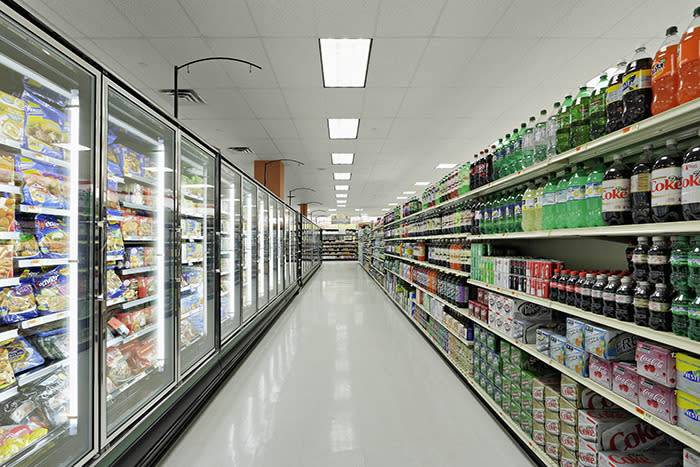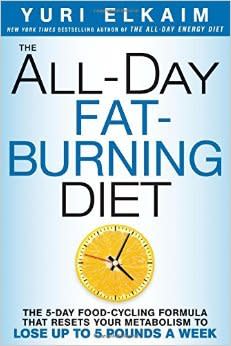The Surprising Fat Trigger You Eat Every Day

Many foods are engineered to taste great — and they wreak havoc on your waistline. (Photo: Tom Sibley/Corbis)
We humans have the same neurobiology as we did hundreds of thousands of years ago, but we now live in a much different environment. This has led us to eat more food without even being aware of it. Much of the blame rests in the hands of food companies that engineer flavor in order to make what we eat more addictive. These products are sometimes called “Frankenfoods.” And you’re about to hear how they’re destroying your body and making you fat.
There are many causes of obesity, but one indisputable fact is that calorie consumption has increased dramatically over the past few decades. It’s important to keep in mind that it is not some collective moral failure that has driven our increased calorie intake. Instead, since all behavior is driven by our underlying biology and its interaction with our environment, we have to consider how the changes in our food supply have altered the way our brains and hormones work. In other words, changes in our food supply have caused malfunctions in our bodies, which are designed to protect us from getting fat. This is a big reason for the increased calorie intake and weight gain, not a lack of willpower.
I want to give you a handle on why you have food cravings, why you can’t seem to pass on dessert even though you’re full, and why even the best of intentions is futile when the wrong foods are in your house. To make sense of all this, it’s important to first understand that your brain ultimately drives all your food-related behavior. All of it.
Related: 10 Discoveries That Made Us Healthier in 2015
Your brain is always collecting information from inside your body and from your external environment. It then integrates that information to select the appropriate internal (physiological) and external (behavioral) responses. When it comes to food, your brain is constantly juggling your internal energy status (do you have sufficient calories?) and environmental triggers to determine the most appropriate digestive/metabolic (physiological) and eating (behavioral) responses.
If your body is low on energy (fat stores, calories), your brain will prompt you to eat. Likewise, as you’re about to learn, when you see a TV commercial with a mouthwatering burger (environmental trigger), that, too, can lead to a greater desire to eat, even in the absence of hunger.
Related: Healthy Desserts You Can Eat Every. Single. Day.
Much of our ultimate behavior has to do with dopamine centers in the brain. Dopamine is a neurotransmitter intimately involved with rewards. When we do something or eat something pleasurable, dopamine centers in our brains light up like fireworks on the Fourth of July. These areas then send information to other areas of our brains that prompt us to take action to get more of that good feeling. It’s the same mechanism that triggers drug addiction or any other type of highly rewarding behavior. Dopamine is a very important driver of behavior.
For instance, a study in mice showed that dopamine-deficient mice were totally unable to execute any goal-oriented behaviors. They would not even drink or eat until dopamine was surgically injected back into their brains. It’s that powerful! Dopamine thus plays a big role in how we select certain behaviors and helps to explain why eating chocolate cake is much more appealing than eating a boiled potato. More on that in a minute.
To help understand why eating certain foods is more appealing than eating others, we have to understand that our bodies (our brains, really) favor calorie density, fat, sugar, starch, salt, free glutamate, and the absence of bitterness. These are known as innate preferences. They are built-in factory settings that help explain why even babies prefer sweet foods over bitter ones.
As we go through life and eat various foods along the way, we develop “learned preferences,” which are sensory properties that have been repeatedly associated with innately preferred properties. For instance, if we grow up eating sugary cereal and the ingredients in that cereal (think sugar, food dyes, etc.) excite our dopamine centers, we will learn to want more of that food. We learn that this specific cereal makes us feel good, and so we want more of it. It’s classical conditioning at work, just like the famous Pavlovian study on dogs where the ringing of a bell triggered salivation due to the previous association of that bell with the arrival of food.

Eating sugary treats as a kid trains our brains to prefer more of that food as time goes on. (Photo: Getty Images)
From a very young age, we have trained ourselves to desire certain foods over others. We will go to great lengths to eat these foods and, in most cases, will have too much of them, which contributes to weight gain. And if you think about it, it kind of makes sense. Food-reward associations likely evolved to guide us to scarce calorie-dense, nontoxic foods in our ancestral environment. If our ancestors had access to pizza and hamburgers, they would most certainly have chosen those over broccoli.
Eating 100 calories of broccoli requires a lot of broccoli. Eating 100 calories of pizza requires just a few bites. It’s a more efficient way of consuming calories, which thousands of years ago is what our bodies would have wanted to do to survive in a scarce caloric environment. But we no longer live in a scarce caloric environment.
Related: 20 Weird Reasons You’re Gaining Weight Fast
As I mentioned earlier, our main motives for eating come from our internal energy status and our external environment. When we eat to satisfy our internal energy needs, we are eating in response to our body’s hunger signals, which tell us that more calories (energy) are required. However, when we eat based on external environmental signals, we are eating for other reasons. Just browse the Web for pictures of chocolate molten lava cake and see how your body responds. If you’re like me and you love chocolate, then your mouth is probably already watering just reading these words. That’s dopamine at work once again. Those dopamine receptors are anticipating the potential reward — your eating the chocolate cake — which would flood them with dopamine and make you feel alive, at least temporarily.
As you probably know from experience, that urge then persists. It doesn’t just vanish into thin air. This is why food advertisements are so powerful. Their external signals (juicy hamburgers, fresh pizza right out of the oven) trigger one or more of our primal senses, which then prompt us to seek out that food. We don’t stand a chance.
The other reason we tend to eat higher amounts of man-made processed foods is because they provide a weaker “I’m full” signal to the brain. Normally, when you eat food, your stomach stretches, which sends a hormonal signal to your brain to stop eating. Furthermore, when food reaches your small intestine, a similar signal is sent via hormones like peptide YY3-36 and cholecystokinin to notify your brain that you’re satiated.
But here’s the thing: Satiety does not correspond to the calorie count of a food. It is mainly affected by the quality of the food, specifically by the presence (or lack) of certain macronutrients. Protein, fiber, carbohydrates, and fat (in that order) have the greatest satiating effect. Thus, a high-protein, high-fiber meal like salmon with lentils will keep you full longer than a high-carb, high-fat meal like pasta with cream sauce.
Food companies know these facts all too well and specifically engineer their foods to be higher in carbohydrates, fat, sugar, and salt and lower in fiber and protein so that your brain has no choice but to crave more of them. Furthermore, the more palatable a food, the more you have to eat to achieve satiety.
“If you’ve lived on man-made Frankenfoods for years, it becomes a lot harder to give up those foods.”
Let’s be honest about something — kale isn’t nearly as palatable as a cookie. That’s why we don’t willingly eat as much kale and why we can easily polish off a box of cookies in no time. We eat more of what tastes good to us. Processed foods have been designed to taste great and stimulate our brain’s dopamine-releasing pleasure centers. It’s that simple.
Want a simple formula for how to eat more (almost uncontrollably)? Eat foods that taste good and are high in calories, low in fiber, and low in protein. That sounds like most fast foods, if you ask me. This is why being over weight is really not your fault. If you’ve relied on fast processed foods for much of your life (haven’t we all?), then your brain has had a lot of exposure to these highly rewarding (yet fattening) foods. It recalls the taste and how good certain processed foods made you feel. And it will go to great lengths to get more of them in spite of your best attempts to eat well.
Related: 5 ‘Healthy’ Foods That Are the Biggest Waste of Money
I’m not saying that eating healthy is a lost cause, because it certainly isn’t. However, it’s helpful to understand the forces at play and to cut yourself a little slack. Willpower can take you only so far. Consider the following stats at the heart of why we’ve gained so much weight in the past 50 years.
We’ve greatly increased our consumption of inflammatory vegetable fats (canola, soy, corn oils), yet animal fat consumption has actually decreased.
In 1822, the amount of sugar consumed was equivalent to drinking one can of soda every 5 days. Today, we consume that same amount every 7 hours!
The cost of food has plummeted since the 1930s, from 25 percent to 10 percent of disposable income, which means we’ve been able to buy and eat more food. And now 43 percent of our food expenditure occurs away from home (i.e., in restaurants, via takeout), compared to just 13.4 percent back in 1929.
There’s more food variety than ever before. In 1980, the average US supermarket carried 15,000 food products. By 2012, that number had soared to 43,000 food products, which means there are more ways to eat the very foods and ingredients that are making us fat and robbing our health.
When you combine all of these factors with the fact that food companies now engineer their foods to please our most primal desires, it’s no wonder more people are overweight and obese than ever before. To make matters worse, once obesity is established, overeating becomes a habit that is hard to break.
Why? A big reason is the hormone leptin. Under normal circumstances, your body fat secretes leptin in proportion to its size. The more fat, the more leptin. This hormone then tells your brain’s command center — the hypothalamus — to stop eating because enough energy (i.e., fat) is present.
When you lose weight, fat stores decline and leptin goes down. The hypothalamus then kicks in and prompts you to eat more (and decrease energy expenditure), fat cells grow, leptin goes up, and food intake and energy expenditure normalize. So you’d think that having more fat would be a good thing since it tells your brain to stop eating, right?
Sadly, that’s not what happens. As with many other hormones, the more that is present and constantly knocking on the door of its receptor site, the greater the likelihood that you lose sensitivity to that hormone. Essentially, you stop responding to it. In this case, too much body fat leads to leptin resistance, which means that leptin’s “I’m full” signal does not reach the brain and you end up eating more and more food.
“Too much body fat prevents the ‘I’m full’ signal from reaching your brain.”
Leptin resistance is also significantly associated with inflammation response in the hypothalamus. Research has shown that C-reactive protein (a marker of inflammation) binds to leptin and attenuates its physiological functions. So, anything that creates inflammation in your body (think gluten, dairy, alcohol, rancid vegetable oils, etc.) can eventually disrupt leptin signaling in the brain, which means that you’re more likely to eat more food than your body really needs. It’s also well known that fructose consumption causes leptin resistance, so put down that can of soda or sugary bottled juice!
As you can see, an arsenal of internal and external factors influences how much we eat. And it seems when we override our internal needs by continually giving in to external temptations, our internal regulation of food intake eventually becomes severely disrupted.
An altered internal physiology, along with the external presence of foods engineered to be extremely tasty — high in sugar, fat, and salt and low in satiety-inducing protein and fiber — explains why we’re fatter than ever before. It’s also part of the reason why we’re more likely to eat cheesecake after a big meal, even though we’re stuffed, than a boiled potato.
Excerpted from The All-Day Fat-Burning Diet by Yuri Elkaim, available now.

Read This Next: Hillary Clinton’s (Spicy) Wellness Secret
Let’s keep in touch! Follow Yahoo Health on Facebook, Twitter, Instagram, and Pinterest.

